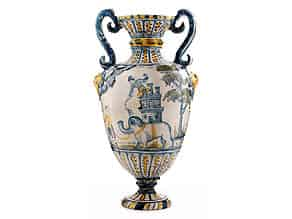Vente Majolique
» reset
Votre assistant d‘art personnel

Voulez-vous acheter un objet similaire?
Nous vous informons volontiers si des objets similaire vendus dans une de nos prochaines vente aux enchères.
Veuillez accepter notre politique des confidentialité
575
Majolika-Apothekergefäß
Höhe: 62,5 cm.
Durchmesser: 31 cm.
Castelli, 17. Jahrhundert.
Prix de catalogue € 10.000 - 12.000
Prix de catalogue€ 10.000 - 12.000
$ 10,800 - 12,960
£ 9,000 - 10,800
元 78,200 - 93,840
₽ 994,900 - 1,193,880
Hohe Arznei-Vase auf Balusterfuß mit elegantem, S-förmig geschwungenem Doppelhenkel und engem, sich nach oben öffnendem Hals. Fuß und Hals sind mit einem geometrischen Streifenmuster dekoriert, der Hals zusätzlich mit Eierstabdekor. Auf der Schauseite ist König Mithridates in einer Landschaft dargestellt. Er trägt ein antikisches Gewand und eine Krone. In der einen Hand hält er ein Salbgefäß empor, die andere hält zwei längliche Pflanzenteile. Rückseitig ist ein Elefant zu sehen, der von einem größeren Mann geführt wird und einen burgartigen Sitzaufbau trägt. Auf diesem sitzt ein Reiter mit mehrschwänziger Geißel. Bemalung in Gelb, Orange, Blau und Grün auf weißem Fond. Fuß wieder angesetzt, Bruchrest.
Anmerkung:
Mithridaticum war eine Arzneimittelzubereitung, die der Behandlung von Vergiftungen diente. Es soll von König Mithridates VI. von Pontus im 1. Jahrhundert v. Chr. erfunden worden sein. Vgl. Rudolf E. A. Drey, "Apothekengefäße. Eine Geschichte der pharmazeutischen Keramik", München, 1980, S. 224, Glossar. (9300079)
Maiolica drug jar
Height: 62.5 cm.
Diameter: 31 cm.
Castelli, 17th century.
Tall drug jar on a baluster shaped foot, with a pair of elegant, S-shaped handles, a narrow neck and everted rim. Foot and neck are decorated with a geometrical striped pattern, the neck additionally painted with egg-and-dart band. The front depicts the mythological scene of King Mithridates in a landscape. He wears an antique garment and a crown and holds up an ointment vessel in one hand and two plants in the other. On the reverse, a man guides an elephant that is smaller than its guide; another man, seated in a chair in the form of a castle on the back of the elephant holds a multi-tail whip. Painted in yellow, orange, blue and green on a white ground. Foot broken and re-stuck; cracked and restored.
Notes:
Mithridaticum is a drug that was used to treat poisoning. According to legend, the drug was developed by King Mithridates VI of Pontus in the first century BC.
See Rudolf E. A. Drey, Apothekengefäße. Eine Geschichte der pharmazeutischen Keramik, Munich, 1980, p. 224, glossary.
This object has been individually compared to the information in the Art Loss Register data bank and is not registered there as stolen or missing.
Votre assistant d‘art personnel
Vous voulez être informé quand dans nos prochaines ventes aux enchères une œuvre d‘art similaire sera proposée? Veuillez activer votre assistant d‘art personnel.
Veuillez accepter notre politique des confidentialité
Voulez-vous acheter un objet similaire?
Voulez-vous acheter un objet similaire? Acheter en vente privée dates de vente aux enchères
Nos experts vous aident personnellement dans votre recherche d‘objets d‘art.
Voulez-vous vendre une œuvre similaire?
Livrez maintenant Vente privée FAQ
Vos envois sont toujours les bienvenus. Nos experts se feront un plaisir de vous conseiller personnellement, nous nous réjouissons de votre appel.
Contactez nos experts
further catalogues Meubles | Tableaux du XVI - XVIII siècle | Porcelaine, argenterie, cristal de roche | Bibliothèque | Sculptures et Haute époque | Ceramique | Majolique | Hampel Living | Tableaux du XIX - XX siècle | Art russe | Art moderne | Art d'Asie, Bijoux & Montres | Livres, dessins et gravures | Art populaire et Divers
















